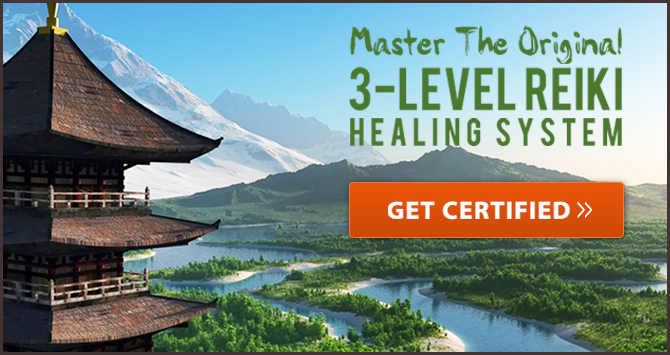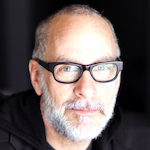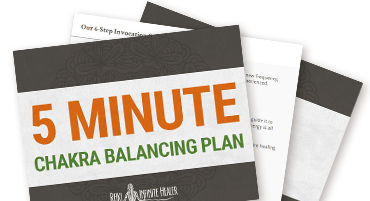What is Reiki?

The best way to answer the question of “What is Reiki?” is to have you feel it yourself with a quick demonstration...
Try placing your palms just an inch or so away from your cheeks. Do you feel anything? A warmth... a vibration… or a comforting sensation?
That is “Universal Energy” flowing out of your palms and into your cheeks.
Reiki is the art of tapping into the Universal Energy that is in and around you, channeling it out of your palms, and into certain areas of the body to heal.
- It can be used to heal yourself or others.
- It uses safe and natural energy without harmful side effects.
- It can be used to heal your body on a physical level and beyond… restoring balance to your spiritual being, as well.
In these ways, Reiki is truly a holistic healing art that treats your whole self.
Just imagine having the ability to release emotional baggage, clear your system of negative energy, rid your body of aches and pains, and align with the things that truly matter to you…
What would this life look like for you?
You’re in the right place, my friend. I’d like to tell you everything you need to know about Reiki.
You’re about to learn how it can help you alleviate your physical and emotional pain, including an easy hand position you can use to cure your headaches and migraines. Plus, I’ll share the inside secrets about the Reiki symbols typically reserved only for Reiki Masters.
Before we dive deeper into how you can connect to your natural healing potential, I want to clarify a common misconception about Reiki…
Reiki is Not Tied to Any Specific Faith… It’s for Everyone!
Many people who are unfamiliar with Reiki believe that it is tied to a specific religion or belief system. But that’s just not true.
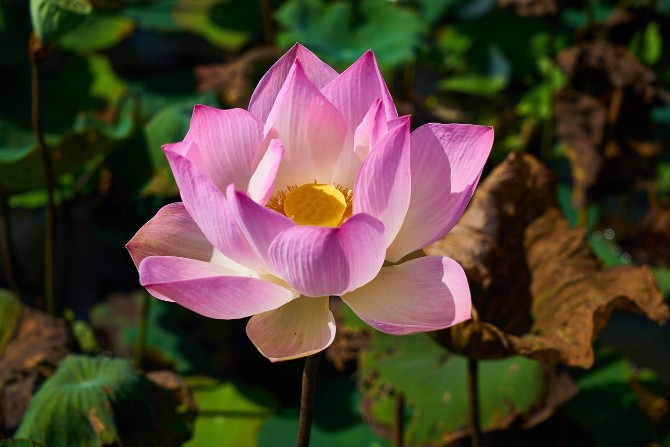
Reiki is a universal healing art.
It’s not reserved for a special class of people, or only those who practice a certain religion. Reiki is available to all those who are willing to be receptive to it. No conditions required.
Reiki is for all. No one can claim it, or copyright it, or reserve it solely for themselves. It belongs to no one person, but to the entire universe and all of humanity.
As a human here on Earth, Reiki belongs to YOU.
If you want to skip this article and dive right into healing yourself and those around you, click here to learn exactly how you can start healing with Reiki now.
I created the Reiki Home Course so that this healing practice can be accessible to anyone who is ready to learn. I hope to spread Reiki all over the world. And that starts with you.
Now that we’ve cleared that up, you may be wondering, “What can Reiki do for me?”
The Benefits of Reiki
Reiki is a powerful healing art that can transform your physical, emotional, and spiritual body. The list of benefits is exhaustive, but here are a few of the many ways that Reiki can help you…
On the mental level, Reiki can…
- Clear your mind of excess chatter and confusion
- Turn stress, anxiety, and fear into a state of calm and relaxation
- Focus your thoughts to aid your problem solving abilities
- Release emotional trauma from your past
- Erase negative thought patterns to make space for new behaviors
In the physical body, Reiki can…
- Accelerate the healing of cuts, scrapes, and other wounds
- Relieve pain including back pain, arthritis, headaches, and more
- Prevent the development of disease, including obesity
- Detoxify your system and remove unwanted toxins
- Strengthen your immune system to ward off new illnesses
Spiritually, Reiki can…
- Connect you to the universe
- Help you realize your life’s true purpose
- Illuminate the path to reach your highest potential
- Amplify your intuitive abilities

As for your emotions, Reiki can…
- Heal broken or troubled relationships
- Allow you to deeply connect with and understand you emotions
- Bring more positivity into your life
- Help you be more compassionate, caring, and loving to yourself and others
From healing addictions, to preventing disease, to repairing childhood trauma, to learning to go with the flow… There is no limit to what Reiki can do.
All of this is possible, and more. Your healing starts with your first Reiki Treatment...
What Happens in a Reiki Healing Session?
If you’ve never tried Reiki before, the concept of a healing session may be a bit mysterious and intimidating.

Is it like a massage? Is it a therapy session? Do I have to take my clothes off?
These are just some of the common questions I’ve had clients ask me before they experience Reiki for the first time.
The answer to all three of those questions is “no.” While every Reiki practitioner does things a little differently, you can expect to experience something like this…
You’ll be greeted by the Reiki Healer, who warmly shakes your hand and introduces him or herself. The soft, soothing music playing in the background will make you feel more at ease.
You’ll take a moment to share a little bit about yourself and what you’d like to accomplish in the healing session. Then the practitioner will go over exactly what they plan to do.
Next, you’ll lie down on a therapy table, fully clothed, with your arms and legs stretched out long. Most practitioners start with their client laying on their back, looking up at the ceiling.
Once you’re relaxed and comfortable, the Reiki session will begin. If you feel comfortable enough, you can close your eyes so that you can really enjoy the experience.

During the session, the practitioner will move to various parts of your body, starting at your head and moving down toward the feet. At each position, they’ll rest their hands on specific areas of the body for several minutes, so that they can channel energy to you.
In more sensitive areas, or if you have irritated skin, their hands may hover just above your body instead of actually making contact.
While they perform the healing work, you can experience a number of different things…
- Hot or cold sensations
- Itchy or tingling skin
- Intense rush of emotions
- Involuntary movement, or the sensation that your body is moving while sitting still
- Memories resurfacing
Each person is different, so one or two of these things may happen to you, all of them could happen, or none. Sometimes, you won’t experience these until a few days or weeks after your treatment. Reiki works on a subtle layer of your body and can take time to really take effect.
A full body treatment usually takes anywhere from 60 to 90 minutes to complete. At the end of the session, the Reiki Healer will offer you a glass of cold water to help you ease back into your day.
That’s the typical process of a Reiki session. But how does someone putting their hands on your body actually make you feel better?
How Does Reiki Work?
There once was a Japanese monk named Dr. Mikao Usui...
Like many other monks before him, he worked with Universal Energy… the Lifeforce that flows through everything in our Universe and powers our bodies.
He used it to heal, protect, and learn the mysteries of nature.
What made Dr. Usui unique is that he wanted to share his knowledge of healing with the world, and so he created the art of Reiki, an easy system that anyone could use to heal.

Let’s break it down. Reiki (pronounced “RAY-KEY” in the west) is a Japanese word with two parts:
- “Rei” means universal, omniscient wisdom or spiritual consciousness
- “Ki” means life force, energy, and vitality
Putting the two parts together, you get the universal lifeforce, or the omniscient wisdom of the limitless energy.
When you are healthy, energy is able to flow freely through your system. But when energy gets stuck and can’t reach all the parts of your body, you can experience disease, emotional pain, or spiritual distress.
There are seven major energy gateways in your body, which are known as Chakras. These gateways absorb energy from the Universe for your body to use. We’ll go into more depth about the Chakras in just a moment.
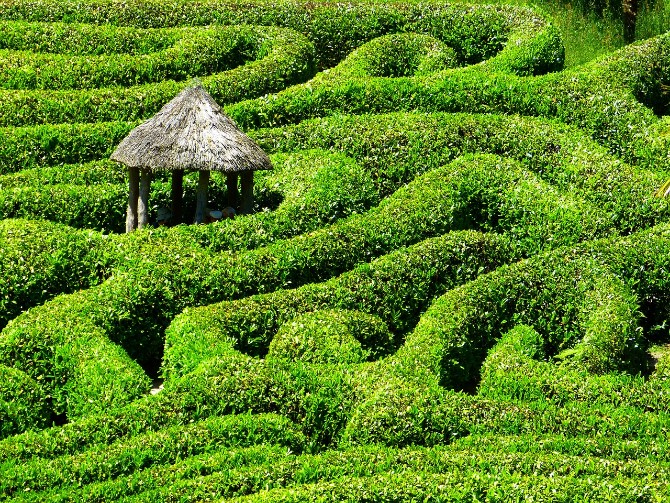
Reiki energy works because it is positive energy that vibrates at a higher frequency. When that powerful energy comes close to your body, the energy in your body starts to raise its vibrations to match the higher frequency of the positive energy.
So, a Reiki healer will channel positive energy from the universe into the person who needs it. Introducing this positive energy into a person’s energetic system allows them to begin to heal.
But how do Reiki practitioners access this powerful energy?
The 3 Levels of Reiki Training
Within the art of Reiki, there are three different levels. All practitioners, no matter what level they have reached, are qualified to channel healing energy into your body.
The differences in the levels simply comes from the amount of knowledge and skills a Reiki practitioner has, which can allow them to heal in different ways and at different speeds.
During level one, also called the first degree, you’ll start by learning self-healing techniques. It’s important to begin practicing on yourself so that you can develop the skills and intuition that you need to perform a healing treatment on someone else.
Once you’re confident in your abilities to heal yourself, you then learn the proper techniques to heal others. There are 19 different hand positions to learn that each affect a different area of the body.

Like I said earlier, this is enough training to spend a whole life healing yourself and others. But those who are called to do so, move on to level two.
One of the greatest advantages of moving to Level two is that you cut the healing time from 60-90 minutes, down to 15-30 minutes. Being able to treat clients faster means that you can help more people!
You’ll also grow your Reiki skills as you learn the first three symbols, Cho Ku Rei, Sei-Heiki, and Hon Sha Ze Sho Nen. These can supercharge your healing sessions and allow you to send healing energy across time and space. More on those in just a moment.
Those who seek further knowledge go on to become Reiki Masters. In the third level of training, you learn the Master Symbol, Dai Ko Myo, which allows you to deepen your connection to Reiki.
Reiki Masters, like myself, are the only people qualified to teach Reiki to others. And as a Reiki Master, you learn to perform a Reiki Attunement so that you may now pass on the gift of Reiki to others.
If you’ve never heard of an Attunement before, don’t worry. It’s a simple process we’ll look at right now…
What is a Reiki Attunement?
Everyone has the ability to perform basic Reiki Healing with a little practice...
But in order to tap into more powerful and advanced techniques, you must go through a process of raising your spiritual energy. This is called an Attunement, and it’s done at each of the 3 levels of Reiki.There are a few ways you can do this…
- Direct Attunement from a Master
- Distance Attunement from a Master
- Self-Attunement

Now there’s a common misconception out there that “once you’ve been attuned, the power of Reiki will stay with you for the rest of your life”.
This is simply not true.
No matter which method you choose, you’ll need to re-attune yourself occasionally to maintain a strong connection to Reiki.
You wouldn't believe how many people have come to me and told me they experienced a "connection fade" even though their Master told them they would only have to be Attuned once.
I recommend re-attuning every 6 to 12 months to the highest level of Reiki you’ve achieved, but listen to your gut and you’ll know when it’s time.
So let’s look at your 3 Attunement options in detail...
First is the direct Attunement from a Master. If you choose this method, you’ll go through an Attunement ceremony.
While you’re seated in a chair, the Reiki Master moves around you as they place their hands in various positions and use the Reiki symbols to connect you to the energy of the universe.
While it’s nice to have a Master do all the Attunement work for you, some of the down sides are that you must seek out a Reiki Master in person, pay high prices, and then hope they actually did the Attunement properly.
This can be impractical for most people, especially considering you’ll need to go back and do this process at least once or twice a year for it to be effective.
Your second option is a Distance Attunement from a Master. This is basically the same as getting a direct Attunement from a Master, except that they send the Attunement energy to you without you having to be there in person.
The advantage of this method is you can contact a Reiki Master anywhere in the world and have them send you an Attunement without you having to go anywhere. You’ll also have a much bigger pool of Masters to choose from since you won’t be limited by location.
However, this method can still be costly and you need to make sure the Master actually does the Attunement correctly.
The third method is to perform a Self-Attunement. I like this option for myself and my students because you have the power to maintain your own connection to Reiki and don’t have to rely on anyone else.
It’s also less expensive because you can just re-attune yourself any time without having to pay a Master to do it.
I also find that healers who have self-attuned have a stronger connection with Reiki because the energy doesn’t get filtered through a master.
If you’d like to know the exact process for attuning yourself to Reiki, it’s all explained in my Reiki Home Course. Instead of paying expensive fees to have a master attune you, use my simple methods to attune yourself.
Click here to learn more about my affordable program that guides you from a Reiki Novice to a Reiki Healer.
Part of becoming attuned to Reiki, is understanding your energetic makeup…
Your Energetic Body: Your Chakras and Your Aura
Reiki targets your energetic body, which is made up of your Aura and the seven major Chakras.
Your Aura is all the energy connected to your physical body, including the energy around and inside of it. The health of your Aura is dependent upon the health of your Chakras…
A Chakra is a spinning vortex that allows energy to travel into and out of your body. These seven energy centers control how much energy is available for your system to use at any given time.
Each Chakra has its own color, and controls the functioning of a specific aspect of your life. Here are the seven Chakras, starting at the base of the spine and moving to the top of the head…
- Root Chakra (red): basic physical needs, connection to the earth, grounding, and will to live
- Sacral Chakra (orange): sexual energy, passions, and creativity
- Solar Plexus Chakra (yellow): logical thinking, focus, drive, and motivation
- Heart Chakra (green): abundance, compassion, and capacity for human love
- Throat Chakra (light blue): communication, self expressions, and truth
- Third Eye Chakra (indigo): intuition, memory, and visualization
- Crown Chakra (violet): spiritual enlightenment, connection to your highest self, and feeling of oneness with the universe
Ideally, all seven of your Chakras should be open and balanced to allow energy into your system.

When a person is unhealthy, either physically, emotionally, or spiritually, their Chakras are not functioning properly. The role of a Reiki practitioner is to identify which Chakras are out of balance, then channel the positive, loving energy of Reiki to help rebalance the Chakra.
And the main way that Reiki Healers transfer energy into a client is through their hands…
Reiki Hand Positions
Traditional Reiki treatments are done by placing your hands on your body, or on the body of your client. More advanced practitioners are able to send Reiki through time and space, but we’ll talk more about that in a moment.
There’s a specific reason that Reiki uses the hands for healing… Remember the Chakras that we just talked about a moment ago?
There are seven major energy centers on your spine, but you also have a smaller Chakra in each of your hands.
Your hand Chakras are effective at pulling energy in from the universe and delivering it to anything that needs healing.
When you gently place or hover your hands on your own body or the body of a client, you are connecting into Universal Lifeforce Energy to empower the body’s innate healing abilities.

Simply laying your hands on your body allows you to alleviate any aches or pains, calm the mind in times of stress, and prevent sickness and disease.
There are specific hand positions that you’ll learn during your first degree training: one set of positions is used for self healing while another set is used for healing others.
The different hand positions target different areas of the body and relieve specific ailments. For example, the second hand position involves placing both palms on the top of the head to cover the crown Chakra.
The position is effective at relieving headaches and migraines, but also works on digestive disorders and emotional troubles.
However, if you or your client were experiencing immune system problems, hand position seven would be the most helpful.
Not only can these hand positions help resolve issues that are already present, but they can also be used as a preventative measure.
While there are a set of hand positions that you learn and practice when you’re new to Reiki, as you progress you’ll be able to rely more on your intuition…
Listening to Your Intuition in Reiki
The powerful healing practice of Reiki is a combination of technical knowledge, like the hand positions and symbols, and your inner wisdom.
Ever since you were a child, you’ve known how to heal yourself. You were born with this ability. Now you just have to learn how to tap into that energy and wisdom so that you can put it into practice.

And you can do that through meditation…
Meditation is a quiet time of reflecting inward, listening to your body, and noticing the subtle sensations that can help develop your intuition.
Taking time to meditate is a method of energy restoration, allowing your body to restore and strengthen your energetic cycle. And as your energy cycle improves, the healing energy of Reiki will be able to more quickly and easily pass through you and into your clients.
You also need meditation to practice Reiki because it helps you tune out the excess noise of the world so that you can hear your inner voice and your inner wisdom.
It’s important to listen to this voice as it will act as your guide while you are performing a Reiki treatment. The more you practice turning inward to listen, the better you will become at honing your intuition.
And intuition is an extremely important part of your Reiki practice.
As you conduct a treatment session, you’ll move through the various steps that you learn in your training, but there will also be a point where you will need to listen to your intuition.
In the Reiki Home Course, you’ll be taught guidelines for how long to hold certain positions, but in the end, each person is different. It’s up to you and your intuition to do what is best for your client.
In my flexible, easy-to-follow program, you’ll learn the skills to sharpen your intuition, as well as the basic guiding principles. Click here to get all the details.
Not only do you need to develop your intuition, but you also need to be conscious of your intention.
Your Reiki Intention
What is this energy meant to do? What is the goal of the healing session?
Energy channeled for Reiki needs to have a purpose. It can be any one of many different things including…
- Balancing the Sacral Chakra to be more in touch with your emotions
- Clearing leftover energy from a childhood accident to diminish anxiety
- Releasing an energetic block in your chest to help recover from a heart attack
Intention directs the flow of energy to a certain place. But there is also another aspect of intention that you need to be aware of: Your personal goals…
Are you using Reiki for the greater good of a person? Or are you selfishly trying to create outcomes that will benefit only you?
Reiki is a pure and wholesome method of healing that must only be used for good.
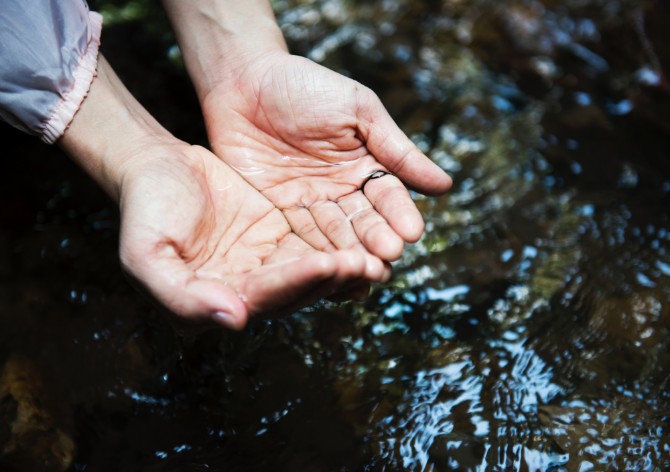
If your Reiki intention is not for the highest good, then you will lose your connection and no longer be able to use it.
An example of a pure and loving use of Reiki is sending healing energy to your sister who has asked you to help her recover from pneumonia.
But if you tell her that you will only help her if she pays you a large sum of money to fund your new sports car, then your Reiki intention is selfish.
It is very important to remember that Reiki is pure and needs to be treated as such, or else you may lose your ability to channel healing energy.
Cultivating an intention will help you direct the flow of energy. But there are also a few tools that can help you as well.
The Power of Reiki Symbols
Reiki can always be used on its own, as it is taught to level one practitioners. The symbols are simply a tool used to help focus your attention and direct the healing energy.
These symbols are very sacred and are to be protected. As a healing professional, you should never let anyone else see you drawing any of the below symbols unless they are Reiki level two or higher.
Many Reiki Masters wouldn’t even be sharing this information with you, but I believe that educating you about Reiki will help spread its healing powers further into the world. So, here are the symbols…
Cho Ku Rei is the Power Symbol. Also called the light switch, it activates all the other symbols and connects you to second degree Reiki Energy.
Sei Heiki is the symbol used for mental and emotional healing. It’s an effective way to reduce addictions, calm any fears, mend troubled relationships, and more.
Hon Sha Ze Sho Nen allows second degree Reiki practitioners to send healing energy to any time and any place. It transcends the boundaries of space and time to making distance healing possible.

Dai Ko Myo is the Reiki Master Symbol, only to be used by those who reach the third degree of training. It is the most powerful symbol and can be used to bring profound changes in one’s life.
There are also many variations and modern interpretations on the traditional versions of the four symbols. The ones listed above are the original symbols developed by Reiki’s founder, Dr. Usui.
Whether or not you choose to use the Reiki Symbols is up to you. But either way, you’ll be practicing one of the more unique healing arts.
There are many things that are unique about Reiki, and because of that, each person who receives this healing energy will experience it in a different way. So the best way to really understand the power of Reiki is to experience it for yourself.
And if you’d like to learn how to use Reiki on yourself and others, my Reiki Home Course is a step-by-step method for mastering the ancient healing practice.
Click here to find out more about how you can tap into the healing wisdom that you didn’t even know you had.
